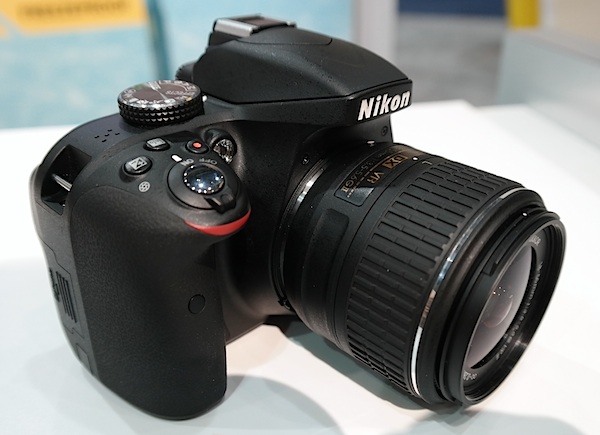Nikon D3300 SLR: It's the Little Things That Matter
Nikon's latest beginner SLR doesn't look much different from its predecessor, but pick it up and you'll feel the difference.

If you were looking at Nikon's lineup of digital SLRs in a glass case (as we did at CES 2014 this week), you might not realize the two trim black models next to each other were different cameras. (They also come in red and silver.) But pull the Nikon D3300 out of the case, and you will feel a big difference from its predecessor, the D3200.
Smaller lens is a big deal
Nikon's new D3300, which goes on sale Feb. 20 for $650 with a basic lens, is noticeably lighter than the D3200, and much of it is due to that lens.
Specification-wise, the lens is pretty standard, with optical image stabilization, a 3X zoom (18-55mm) and a not-too big (or as photographers say, "fast") largest aperture range from f3.5 to f5.6 (depending on level of zoom). But the lens packs it all into a smaller unit that makes the whole camera easier to handle.

Most noteworthy is that, when the lens is not in use, it retracts a bit (Nikon hasn't specified a figure for how much), making the camera easier to carry or pack in a bag, a feature sorely needed in all DSLRs. Even when fully extended, the lens is noticeably smaller than the lens of the same specs that comes with the D3200. (Nikon still has a sizeable stock of D3200s, but it's no longer manufacturing new ones — be on the lookout for markdowns. You can always buy the new lens separately.)
At CES 2014, Samsung announced its own retracting lens, for its mirrorless cameras, which squishes even further down.
MORE: Best DSLRs 2014
One quibble, however, is that you have to press a button to unlock and extend the lens. It doesn't pop out when you turn on the camera, as lenses on point-and shoot cameras do — even those with far greater zooms than the D3300's stock lens.
Get instant access to breaking news, the hottest reviews, great deals and helpful tips.
Performance tweaks inside
Other upgrades are hidden inside the D3300's body, which is a few tenths of an inch smaller than its predecessor's. The biggest little detail is the Xpeed 4 processor, Nikon's latest, which allows the camera to shoot full-HD, 1080p video at the highly desirable rate of 60 frames per second — a rare capability in SLRs at this price range.
The new processor also makes the camera a bit faster than the D3200, upping the shooting speed from four photos per second to five. Parents and sports fans take note — that could mean the difference between getting and missing that key action shot. Nikon also expects the new processor to improve image quality and battery life.
The other big change, the removal of the so-called optical low-pass filter (OLPF) in front of the image sensor, didn't seem to make a difference in our brief hands-on. We were, however, using a pre-production model, running beta-version software, which Nikon made clear may not offer the same quality that the camera will in final retail form.
The OLPF slightly diffuses light before it reaches the sensor. This remedies a few problems with a too-crisp image, such as moiré.
Moiré occurs when a detailed, repeating pattern, such as pinstripes or a fine check, lines up too closely with the pixel grid on the image sensor. The slight mismatch in the two patterns results in nasty wavy interference lines. You'll also encounter moiré if you try to photograph a TV, computer or phone screen, as you get a close mismatch between the screen's pixels and the camera's.
MORE: DSLR vs. Mirrorless Cameras: Which Is Better for You?
Nikon says that the high resolution of the D3300's sensor, which is actually the same one as on the D3200, makes moiré lines so tiny that you wouldn't see them.
In our quick test, that seemed to be the case. A helpful Nikon PR representative in a fine-patterned checked shirt modeled for us. Shooting with both the D3200 and the D3300, we saw no difference between the two. Removing the OLP filter apparently did no harm.
We couldn't tell if it helped, however. The details in photos taken by both cameras looked about the same, even when zoomed in all the way.
There are a number of "howevers" to this observation. We were trying a pre-production camera, and final software tweaks for a camera are often when fine detail rendering gets perfected.
Furthermore, the lack of improvement may depend on the lens. Nikon's kit lens is quite good, but even Nikon would say that it's not as sharp as its professional-level lenses, which cost several times more. (It's those superfine performance refinements that cost so much to achieve.)
Should you upgrade?
If you have a D3200 already, you can probably skip this upgrade. You'd get more for your money by upgrading to a model such as Nikon's D5300, which also has the latest processor and lack an OLP filter.
But if you are in the market for a starter DSLR, and you like the feel of Nikons, it's worth waiting six weeks for the D3300.
Follow Sean Captain @seancaptain and on Google+. Follow us @tomsguide, on Facebook and on Google+.
Sean Captain is a freelance technology and science writer, editor and photographer. At Tom's Guide, he has reviewed cameras, including most of Sony's Alpha A6000-series mirrorless cameras, as well as other photography-related content. He has also written for Fast Company, The New York Times, The Wall Street Journal, and Wired.
